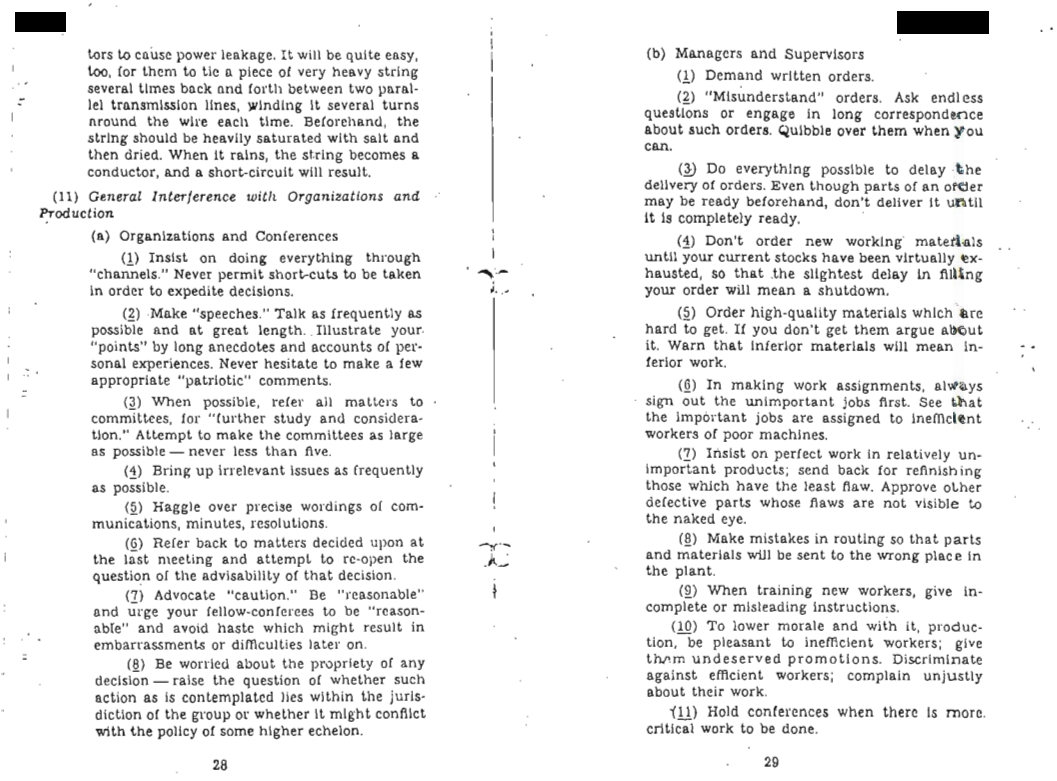Ever been in a meeting where it seemed it was designed to suck all life out of the attendants? Ever met a manager or a colleague that seemed to work against the company interest? It might very well be that it is for exactly that reason – because it was -at least once- considered to be a way to sabotage a company.
I often use it as a reminder in my presentations on how flawed organisations often are, how we can design better meetings and gettogethers and how we can better spend our time.
The Simple Sabotage Field Manual
It was the end of the Second World War in 1944, when the United States Office of Strategic Services released it’s Simple Sabotage Field Manual, a guide how to sabotage the occupying forces in occupied Europe. It was distributed as a secret pamphlet that was intended as a guidebook to citizens living in Axis nations who were sympathetic to the Allies.
The Office of Strategic Services
The Office of Strategic Services (OSS) was a wartime intelligence agency of the United States during World War II, and a predecessor to the Central Intelligence Agency (CIA).
The Simple Sabotage Field Manual
The “Simple Sabotage Field Manual,” declassified in 2008 and available on the CIA’s website, provided instructions for how everyday people could help the Allies weaken their country by reducing production in factories, offices, and transportation lines. As the CIA now states on their website “Some of the instructions seem outdated; others remain surprisingly relevant” and “Together they are a reminder of how easily productivity and order can be undermined”.
How to sabotage organisations and conferences
- Insist on doing everything through “channels.”
- Never permit short-cuts to be taken in order to expedite decisions.
- Make “speeches.”
- Talk as frequently as possible and at great length.
- Illustrate your “points” by long anecdotes and accounts of personal experiences.
- When possible, refer all matters to committees, for “further study and consideration.” Attempt to make the committee as large as possible – never less than five.
- Bring up irrelevant issues as frequently as possible.
- Haggle over precise wordings of communications, minutes, resolutions.
- Refer back to matters decided upon at the last meeting and attempt to re-open the question of the advisability of that decision.
- Advocate “caution.” Be “reasonable” and urge your fellow-conferees to be “reasonable”and avoid haste which might result in embarrassments or difficulties later on.
How to sabotage companies as a manager
- In making work assignments, always sign out the unimportant jobs first.
- See that important jobs are assigned to inefficient workers.
- Insist on perfect work in relatively unimportant products; send back for refinishing those which have the least flaw.
- To lower morale and with it, production, be pleasant to inefficient workers; give them undeserved promotions.
- Hold conferences when there is more critical work to be done.
- Multiply the procedures and clearances involved in issuing instructions, pay checks, and so on.
- See that three people have to approve everything where one would do.
How to sabotage companies as an employee
- Work slowly.
- Contrive as many interruptions to your work as you can.
- Do your work poorly and blame it on bad tools, machinery, or equipment. Complain that these things are preventing you from doing your job right.
- Never pass on your skill and experience to a new or less skillful worker.
A lesson?
If the Office of Strategic Services, if the CIA considers it a succesfull way to sabotage companies or colleagues … maybe we should just stop doing it.





1 comment